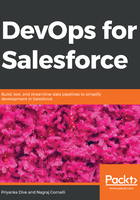
上QQ阅读APP看书,第一时间看更新
Conventions used
There are a number of text conventions used throughout this book.
CodeInText: Indicates code words in text, database table names, folder names, filenames, file extensions, pathnames, dummy URLs, user input, and Twitter handles. Here is an example: "Enter apex stat into the command panel."
A block of code is set as follows:
<?xml version="1.0" encoding="UTF-8"?>
<Package xmlns="http://soap.sforce.com/2006/04/metadata">
<version>42.0</version>
</Package>
When we wish to draw your attention to a particular part of a code block, the relevant lines or items are set in bold:
<?xml version="1.0" encoding="UTF-8"?>
<Package xmlns="http://soap.sforce.com/2006/04/metadata">
<version>42.0</version>
</Package>
Any command-line input or output is written as follows:
$pmd -d "Source Path" -R apex-ruleset -language apex -f CSV > "Destination Ptah\ReportName.csv"
Bold: Indicates a new term, an important word, or words that you see on screen. For example, words in menus or dialog boxes appear in the text like this. Here is an example: "Enter the Project name and Organization Settings details for connection."
Warnings or important notes appear like this.
Tips and tricks appear like this.